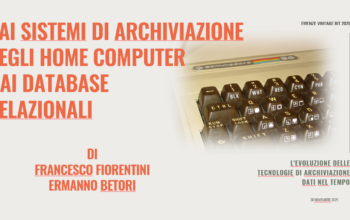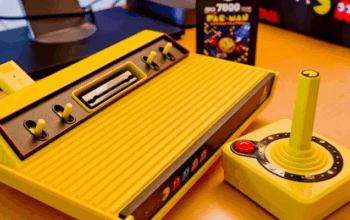
People involved in the preparation of this issue of RetroMagazine World (in no particular order):
- Alberto Apostolo
- Dr. Andrea Q.
- Carlo N. Del Mar Pirazzini
- Daniele Brahimi
- Mic the Biker Novarina
- Francesco Fiorentini
- David La Monaca
- Leonardo Miliani
- Giuseppe Rinella
- Christian Miglio
- Ermanno Betori
- Roberto Del Mar Pirazzini
- Ingrid Poggiali
- Gianluca Girelli
- Roberto Zaffanella
- Maurizio Diamanti
- Roberto Lari
- Giorgio Balestrieri
- Alessandro Gatti
- Cover & full-page image: Giuseppe Mangini
- Cover layout: Carlo N. Del Mar Pirazzini
Editorial by David La Monaca
The unknown variable called time
If there is one thing today that we have got in great quantities in retrocomputing, it is resources to draw on. The Internet offers us countless opportunities to retrieve documentation, books, magazines, guides and manuals for our beloved computers. It’s so easy to find both digital and traditional material. And then there’s the vintage hardware. For years, cellars, attics and car garages have been looted and thousands of famous and widespread 80s/90s computer models have emerged. This is all to the advantage of collectors and enthusiasts who bought them at modest prices, then they repaired and tested them and, in some cases, got real in-depth use out of them, perhaps like they used to, back in the day. Putting together a collection of respectable hardware does not take much in terms of money, after all, unless you want to own those few models or peripherals of a certain rarity that have become an expensive investment. Certainly a few years ago the prices of second-hand computers were (much) lower on average. But with a little patience, a little constant research, a little technical knowledge, a little trusted knowledge (for example, subscribing to Facebook groups or forums specialised in certain brands helps a lot), all in all, you can also buy up some fun at good prices. Let’s not forget the most important ingredient of all: caution, because fraud by real scammers or speculating sellers is always around the corner. Careful attention should be paid to prices that are too low or bids that are too tempting.
All of us retrocomputing enthusiasts could limit ourselves to emulators. Why not? After all, many of these have reached an astonishing maturity and with the right resources and settings, achieving a look-and-feel very close to the good old physical machines is basically guaranteed. But it’s not the same – it’s not enough: nothing can replace the thrill of touching the plastic or metal of the cases, typing commands on a real keyboard, even smelling the overheating of the ICs and CRT monitors, hearing the noise of the disk drive while loading the programs, admiring the original colours of the games and so on. Not even the “reproduction” (often absolutely faithful) and the flexibility provided by FPGA boards such as MISTer and MISTICA can compete with the sensations provided by the real machines.
And then, let’s face it, the search for old hardware also provides its share of fun. Dealing daily with the prestigious brands of a now defunct market, looking for models and accessories considered unavailable, discovering computers and consoles that survived for only a few years, following the innovations of modern peripherals that can be connected to old machines and making the user experience comfortable and efficient. All this is incredibly exciting and fun.
And all this takes time. So much time spent reading forums, attending groups of users to ask questions and provide answers, downloading and reading books and magazines that are three or four decades old, scouring classified sales sites and much more. Of course, there is also a downside: that sense of frustration for all the time that is needed and will probably always be needed in order to be able to deeply study and make the best use of the computers that we have managed to accumulate. Think about it, any 8-bit computer in itself represents an endless mine of ideas, resources, and possibilities of use both from a software and hardware point of view. One life would not be enough to go into every single aspect of it, let alone dozens of different machines.
Time. The time variable that, even for this small hobby activity of ours, turns out to be the most precious currency available.
Summary:
- Apple II
- NES – (un)protected
- Pandora’s Box EX
- The NanoComputer Z80 Learning System
- MAXIM, the arcade room since 1990 – Part 2
- Retro Interview: discovering new talents
- Q&A with Bill Mensch
- Amiga OS 3.2 – Test and installation
- ZX Master Mind
- Conversion of a number from binary to digital
- BASIC fractals in 8-bit sauce
- Amiga, C64 and MS-DOS… shake hands!
- The importance of preserving software
- GALAGA on C64 by Arlasoft
- Turbo Out Run – justice is served
- ListAmiga: top 10 esclusives
- ZAXXON
- Souls Keeper (MSX/MSX2)
- Briley Witch Chronicles (C64)
- Cotton 2: Magical Night Dreams (Sega Saturn)
- Dragonborne (GameBoy)
- Unmetal (Win/PSVita/PS4/Nintendo Switch)
- The Swarm Is Coming (ZX Spectrum)
- Empire Earth (PC)
- Inca Man (Amiga)
- Prince Of Persia (Atari XL/XE)
- Lufia & the Fortress of Doom (Super Nintendo)
- Magic Castle (PlayStation)
- Quest Forge: By Order Of Wings (NES)
- Puzzle Bobble (Amstrad CPC)
- Street Warriors (C64)








I read this piece of writing completely about
the difference of most up-to-date and previous technologies, it’s amazing
article.